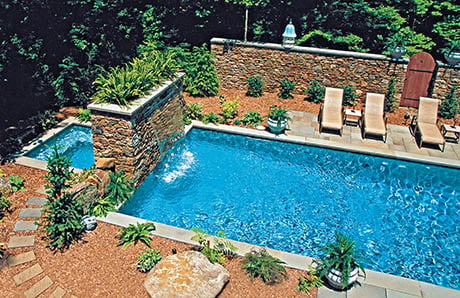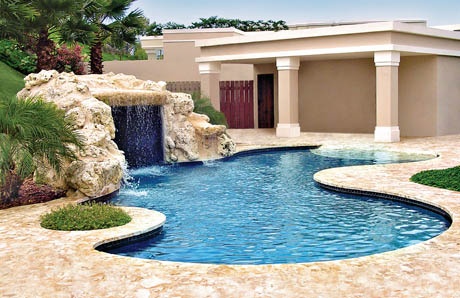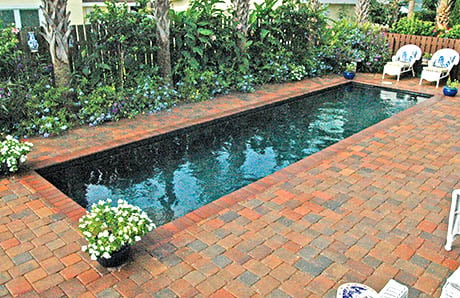Enjoy functionality and style in a private pool designed for fitness
 Form & Function: Unlike generic lap pools at public facilities, the design you have custom built for your backyard can have eye-catching features like this towering planter-cascade waterfall, as well as a private hydrotherapy spa.
Form & Function: Unlike generic lap pools at public facilities, the design you have custom built for your backyard can have eye-catching features like this towering planter-cascade waterfall, as well as a private hydrotherapy spa.
Swimming laps is an excellent form of exercise that delivers a full-body workout. While you may currently make them part of your fitness routine at a community pool or public facility, you could be doing so more comfortably in your own residential lap pool!
Having a private aquatic gym allows you to exercise on the schedule you prefer and to do so in a relaxed, personal setting. That eliminates trips to the public pool, use of communal lockers and showers, and all the logistics that go with them.
Once you’re at a busy community facility, there may not always be enough room for you to swim laps, or there may already be too many other users in the designated lap lanes. But with a lap pool at home, you’re not on anyone else’s time—or lane—except your own!
Along with the practical ease of swimming outside your backdoor comes the potential for greater safety. Your personal pool may be safer and cleaner than public ones used by so many swimmers. With growing concerns about the health hazards in many public aquatic venues across the country, avoiding them—and opting for a swimming environment that you control—is a smart move.
If your main reason for a private pool is getting in those daily strokes, then a lap pool may be right for you. What you may not realize is that a large backyard is not usually needed—nor is devoting as much outdoor space as you might imagine.
You can have your local pool contractor develop a plan that makes the most of your yard space, even if it’s limited. Even better, you can have your builder integrate decorative features to your lap pool that add beauty to your exterior environment.
What is a lap pool?
With the primary purpose of extended swimming, lap designs are almost always simple and strategic. Unlike typical backyard pools—think kidney, L-shape, or free-flowing lagoon shapes—most lap-centered designs either limit decorative and functional features or carefully position them within the pools so they do not encroach on the swimming path.
 Traditional Backyard Pool: This free-form lagoon exemplifies one of today’s popular looks for family-style pools. While attractive with a tropical feel, it’s not friendly for routine laps. The curvy shape blocks any clear course for serious swimming, and the rock grotto and graduated beach-style entry eliminate options for easy lap turns.
Traditional Backyard Pool: This free-form lagoon exemplifies one of today’s popular looks for family-style pools. While attractive with a tropical feel, it’s not friendly for routine laps. The curvy shape blocks any clear course for serious swimming, and the rock grotto and graduated beach-style entry eliminate options for easy lap turns.
Effective lap pools employ a certain shape, length, and depth. Most of these pools—whether public or private installations—are long, slender, and rectangular. Other shapes are possible if the pool is large enough to provide at least 40 feet of straight, unobstructed swimming with enough room for swimmers to comfortably do strokes without frequent turns.
At a public or community facility, a true lap or competition pool is 25 meters (82 feet). But shorter pools—around 40 feet in length—are also considered lap pools. The point here is that lap pools provide a clear path so you can freely swim without obstacles.
As for depth, many public lap facilities are at least 4 feet deep to help swimmers avoid scraping their arms on the pool’s floor while they stroke. This depth also provides enough room to do a flip turn, if desired, at the end of each lap.
 Public Lap Pools: At shared-use aquatic venues, lap pools are often wide enough to simultaneously accommodate several swimmers. The pool bottom may also have black lane markers to serve as a guide for doing laps. On the water surface, floating ropes may also be used to separate lanes.
Public Lap Pools: At shared-use aquatic venues, lap pools are often wide enough to simultaneously accommodate several swimmers. The pool bottom may also have black lane markers to serve as a guide for doing laps. On the water surface, floating ropes may also be used to separate lanes.
Lap pools are also configured to make lane turns easy. When swimmers reach one end of the pool and need to start another lap, they encounter a straight flat wall from which to push off. In addition, there may also be a tile or color marker on the wall at the end of each lane to serve as a visual target for swimmers.
On the other hand, turning may not be so easy in a traditional backyard pool or certain hotel/resort pools. Depending on its design, the pool might pose obstacles that make turning more difficult. The most common hurdle is the set of pool entry steps.
Other features like a tanning ledge, fountain cluster, or a sloped beach entry, can also get in the way. A spa that juts out into the pool is yet another feature that can impede swimmers and interrupt their concentration.
 Not for Laps: At first glance, this design looks like a quintessential lap pool. But it’s not: Two features nix it from the lap lane. First, notice the entry steps at one end. Unlike a true lap pool with a flat wall to facilitate push offs, these steps make turning problematic. Second, the spa is in the way; its walls extend into the swimming area, interfering with the lap route.
Not for Laps: At first glance, this design looks like a quintessential lap pool. But it’s not: Two features nix it from the lap lane. First, notice the entry steps at one end. Unlike a true lap pool with a flat wall to facilitate push offs, these steps make turning problematic. Second, the spa is in the way; its walls extend into the swimming area, interfering with the lap route.
Design options that distinguish private lap pools built in homes
Like their public counterparts, residential lap pools are conceived to provide an optimal swimming environment. They just have to do so on a smaller scale—but usually also with much more design inspiration and visual appeal.
To fit into a typical backyard, lap pools are usually 35 to 40 feet long. While shorter in span than a large public one, you will still have a reasonable stretch for laps before you need to turn. In an ultra-compact yard, a lap pool can be shorter as long as you are okay with making more turns during workouts.
The vast majority of residential lap pools need to accommodate only one swimmer at a time. So for width, the dimensions can be a minimum of only 8 to 10 feet. That makes a lap pool a viable option in some narrow backyards—or even some side yards.
 Small Yard Solutions: A distinctive paver-stone deck surrounds this simple, dark-bottom lap pool tucked into a small backyard. Some home lap pools may be surprisingly short, as little as 12-feet! Such pools—sometimes referred to as swim spas—employ a high-velocity swim jets, and you can stroke in place against a smooth, continuous current.
Small Yard Solutions: A distinctive paver-stone deck surrounds this simple, dark-bottom lap pool tucked into a small backyard. Some home lap pools may be surprisingly short, as little as 12-feet! Such pools—sometimes referred to as swim spas—employ a high-velocity swim jets, and you can stroke in place against a smooth, continuous current.
Now, if space in your backyard is not at a premium, your lap pool can be laid out much wider. Dimensions of 15 to 20 feet across are often desirable. At that scale, you have a “double-duty” design that provides an environment good for laps and a family playground for fun and splashing around.
As for determining how deep your lap pool should be, consider your height and your type of stroke. You want ample room so your fingers do not reach and scrape the floor as you stroke. Another factor: if your preference is for flip turns—vs. push offs—which require greater water depth. Speak with your pool professional about the optimal depth for your particular needs.
The best part of a lap pool that’s created for your home is that along with functionality, it can have personality! Just because the lap pool at the Y is a boring rectangle doesn’t mean your version can’t have some pizzazz.
Even in a tight yard, your pool builder can integrate a variety of decorative elements, such as in-floor mosaics, iridescent glass tile, elevated fire bowls, and sleek cascade or laminar water features. Space permitting, your pool can have even include a spa, tanning ledge, or swim-up bar.
However, ensuring an open swim path to each end of the pool remains vital. An experienced builder will take care to correctly configure any features into your lap design. Even a basic one matters. For example, the entry stairs should be located on the sides or corners of the pool—vs. at one end of the pool—so they don't interrupt the swimming area or make turns a hassle.
Enjoy swimming at home
Does keeping active and healthy without having to leave home sound good? Are you ready to learn more about home lap pools and how one can fit into your backyard? Ready to get a pool that provides the functionality you need with the beauty and attractive features you want?
Well then, go ahead and take the plunge: Contact pool builders in your area for an in-home consultation and pool-design concept. To inquire about the options available for private lap pools, you can also contact your local Blue Haven Pools office.




.jpg?width=1490&name=rock-waterfall-slide-pool%20(1).jpg)